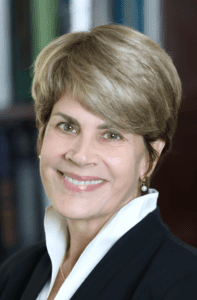
Advances in human genetics & genomics have led to a better understanding of the fundamental biology of sensory systems and inform effective and accessible treatments to improve quality of life. Debara Tucci, MD, MS, MBA, leads the National Institute on Deafness and Other Communication Disorders’ (NIDCD) research and research training programs in hearing, balance, taste, smell, voice, speech, and language. Discoveries in these areas can have a dramatic impact on the lives of the tens of millions of people with deafness and communication disorders.
We recently spoke with Dr. Tucci to learn more about the ongoing research projects at NIDCD in the fields of genetics & genomics and public health.
- What led you to join NIDCD?
I started as the NIDCD director in September 2019, but I have a long history with the Institute. I served in an advisory capacity to NIDCD for both the intramural and extramural programs for a number of years, so when I assumed my role as director, I felt that I knew the organization and had a clear vision for the future, which is to advance the science of communication to improve lives.
- What is the role of NIDCD in informing researchers and the public about the science of deafness and communication disorders?
For over 30 years, researchers supported by the NIDCD have made seminal advances in understanding the normal and disordered processes of hearing, balance, taste, smell, voice, speech, and language, leading to increasingly effective, evidence-based prevention and treatment strategies for diseases and disorders that affect an ever-growing segment of the population.NIDCD provides science-based information to a variety of audiences, including researchers, health care professionals, policymakers, and members of the public who have a vested interest in our mission. One good example of high-impact research is the work on the importance of universal newborn hearing screening and early intervention for hearing loss. Prior to the establishment of a federal program through the “Newborn and Infant Hearing Screening and Intervention Act of 1999,” less than 10 percent of newborns in the U.S. were screened for hearing loss. As a result, almost half of all children born with hearing loss were not diagnosed until their third birthday or later, missing a crucial period for speech and language acquisition. In fact, children begin learning speech and language in the first six months of life, which is why early identification of hearing loss is critical. Currently, according to the CDC, around 98 percent of newborns are screened for hearing loss in the U.S. annually. The newborn hearing screening program may provide a platform in the future for genetic screening that could enable early therapeutic intervention for hearing loss, eliminating the need for lifelong rehabilitation.
NIDCD has a clearinghouse and website that provides plain language health information for the public addressing a range of hearing, balance, taste, smell, voice, speech, and language topics.
- What human genetics research is supported by NIDCD and what are the opportunities for applying genetics-based approaches to understanding and managing communication disorders?
In each of our seven mission areas, NIDCD seeks to identify genes and characterize the molecular mechanisms underlying sensory and communication disorders with the hope that one day this knowledge will improve the quality of life and health of individuals who are deaf, hearing impaired, or present with communication disorders.For example, NIDCD-supported researchers are using whole exome and genome sequencing to identify mutant genes associated with human syndromic and non-syndromic hearing loss. Scientists engineer animal models that mimic human hearing loss and try to understand the pathophysiology of the disorder, and researchers use the models to explore potential gene-based approaches to prevent, reduce, or reverse the condition.
Research teams are developing gene therapies as a treatment option for hearing and vestibular loss caused by mutated genes. For example, researchers supported by the institute use genome editing to correct mutations at a single-nucleotide level to restore normal function in animal models of Usher Syndrome, a rare genetic disorder that affects hearing, balance, and vision.
Taste and smell researchers funded by NIDCD have shown that small variations in our genetic code can raise or lower our sensitivity to bitter tastes, which might influence our food preference or ability to tolerate bitter medicines. This research holds promise for the development of ‘bitter blockers’ that could make life-saving medicines more acceptable to children. It could also be predictive of whether a child will adhere to a particular medicine regimen and inform the prescribing of better tolerated medicines based on an individual’s bitter receptor variations.
In exploring why smell loss is such a common and persistent symptom of SAR-CoV-2, researchers funded by NIDCD examined autopsied nasal tissue from individuals who died of COVID-19. They found that their olfactory sensory neurons produced fewer odor detecting receptors and displayed a disrupted nuclear structure, a genomic structure needed for the proper expression of odorant receptors and their signaling components. Deciphering how SAR-SoV-2 infection leads to disruption of neuronal function is critical to understanding the neurological sequelae of COVID-19.
NIDCD also supported genetic linkage studies that identified four genes linked to stuttering. The researchers engineered mouse lines that carry the mutations that cause stuttering in humans. Like the humans who carry these mutations, these mice are normal in all ways, except that they display subtle differences in their ultrasonic vocalizations. Scientists will use these mouse lines to attempt to identify and potentially target the cells within the brain that mediate this atypical vocalization.
- What are some of the goals and aspirations for NIDCD in the coming years? What most excites you about opportunities for human genetics to improve medicine?

NIDCD will release its 2023-2027 Strategic Plan in early 2023. This plan contains ambitious, but achievable, goals for science in our mission areas—goals that will further our scientific understanding of basic biological systems, human disease mechanisms, and promising treatments. The strategic plan was developed through a collaboration between NIDCD staff, the scientific community, members of the public, advocacy groups, and professional organizations. I am excited that precision medicine has been identified as an important focus. Over 50 percent of early-onset hearing loss is hereditary, and many communication disorders have a genetic basis. Gene therapy and gene editing is an area of great promise for treatment of sensory and communication disorders. NIDCD aims to support research that accelerates genetic and cellular therapies for people with sensory and communication disorders or conditions and to integrate a precision medicine framework into clinical care.
- What are some ways in which NIDCD is seeking to establish partnerships with members of the Deaf community and those affected by communication disorders? NIDCD works closely with advocacy organizations, professional organizations, and members of the Deaf community to share research updates and to solicit information of interest to our audiences. The National Deafness and Other Communication Disorders Advisory Council advises the HHS Secretary, the NIH Director, and the NIDCD Director on matters relating to the conduct and support of research and research training, health information dissemination, and other programs with respect to normal and disordered processes of hearing, balance, taste, smell, voice, speech, and language. The Advisory Council includes leading representatives of the health and scientific disciplines relevant to the areas of deafness and communication disorders, as well as members of the public who bring unique perspectives. NIDCD also collaborates with other NIH Institutes to integrate knowledge bases, expertise, methodologies, and infrastructures in order to address important scientific questions and develop innovative strategies for preventing, diagnosing, and treating a wide range of health conditions. Examples of these collaborations include the BRAIN Initiative®, All of Us Research Program, and a trans-NIH initiative in the area of Alzheimer’s disease and related dementias. In addition, NIDCD maintains a directory on our website of selected national organizations that provide information on communication disorders as a resource for the public, health professionals, researchers, and other audiences.
- When training the next generation of human genetics researchers, clinicians, and public health professionals, what do we need to be teaching them about communication sciences and improving diversity, equity, and inclusion in the scientific workforce?
The NIDCD has long worked to increase the diversity of the research
 pipeline across our mission areas, and since becoming the institute’s director in 2019, I have made expanding diversity, equity, inclusion, and accessibility within the NIDCD and its extramural workforce one of my chief aims. When scientists and trainees from differing backgrounds work together, their unique perspectives and experiences stimulate creativity and innovation, contributing to the excellence of the biomedical research enterprise. Diverse teams are also more likely to ensure that members of underserved populations participate in clinical studies and that the research addresses questions that are meaningful to these communities.Disparities in access to health care and in treatment outcomes occur across our health care system, including communication disorders. Sufficient evidence exists to affirm that communication disorders across underrepresented minority groups have been and continue to be understudied, and these populations are underserved. More research is needed to identify factors that could close the gap in care. Improving access to hearing health care for people with communication disorders is a high priority for the NIDCD, including making assistive technologies such as hearing aids widely available for those who could benefit from them. As of January 2022, the NIDCD supports 20 active research projects on accessible and affordable hearing health care.
pipeline across our mission areas, and since becoming the institute’s director in 2019, I have made expanding diversity, equity, inclusion, and accessibility within the NIDCD and its extramural workforce one of my chief aims. When scientists and trainees from differing backgrounds work together, their unique perspectives and experiences stimulate creativity and innovation, contributing to the excellence of the biomedical research enterprise. Diverse teams are also more likely to ensure that members of underserved populations participate in clinical studies and that the research addresses questions that are meaningful to these communities.Disparities in access to health care and in treatment outcomes occur across our health care system, including communication disorders. Sufficient evidence exists to affirm that communication disorders across underrepresented minority groups have been and continue to be understudied, and these populations are underserved. More research is needed to identify factors that could close the gap in care. Improving access to hearing health care for people with communication disorders is a high priority for the NIDCD, including making assistive technologies such as hearing aids widely available for those who could benefit from them. As of January 2022, the NIDCD supports 20 active research projects on accessible and affordable hearing health care.To raise awareness about our interest in funding research to level these inequities, the NIDCD issued a Notice of Special Interest on Health Disparities and Inequities Research, which encourages grant applications that (1) advance the understanding or reduce the impact of health disparities and inequities in communication disorders among racial/ethnic minority and other underrepresented populations, and (2) address the influence or reduction of racism or discrimination in causing or sustaining health disparities and inequities.
Another important example of our commitment to attract innovative grant applications from the broadest possible pool of talented scientists is the funding opportunity NIDCD Research Opportunities for New Investigators to Promote Workforce Diversity. It is designed for early stage and new investigators from diverse backgrounds conducting research in any NIDCD scientific area.
I am hopeful that these funding opportunities and our commitment to building a diverse biomedical workforce will support the next generation of human genetics researchers throughout NIDCD’s mission areas.
